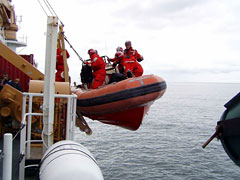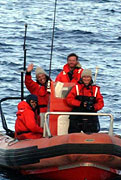

 | |||||||
|
|
Journals 2004/2005Linda Hoffman
August 7, 2004 Humpback sightings today were difficult as they we staying down for a very long time. Photo identification has become more difficult as the flukes were entirely black without patterns. I thus had to strictly see if there were matches along the ridges. I am also using the loupe more often, but with the ship rocking, it is very difficult. I started to feel seasick, so I headed back to my room to lie down. I talked to Holly telling her how someone needs to invent a software program where we can match the flukes on the computer screen. They have something in the animation department of the movie studios; perhaps we should look into it. There is software and matches that are done on the computer, but it is still not a simple procedure. We have made progress with the cameras however. We now shoot with digital cameras, so we don't have to wait to develop it in the field. Also the cost is less since we are not using film. This is a really a wonderful benefit in the field. When I first started studying whales, we had to set up a darkroom in the field to develop the film. It was not an easy thing to do in the field, as the darkroom was an unventilated closet in 120 degree heat. 4pm. I went up to the flybridge to get some air, as I am still feeling sick. Dr. Barlow came up to me and asked me how I was doing. I guess word gets around fast when one is not feeling well. I told him I was doing much better. "Well," he says, "how would you like to go out on the small boat?" I don't know how to reply. My roommate Jessica earlier in the day told me how much strength you need and balance in your legs to ride the waves in the small boat. She actually frightened me. What if I don't have enough strength to hold on? I would be blown off the boat, as there is no harness to hold you down. As these thoughts raced though my mind, Dr. Barlow said again,"The seas will never be calmer than this but its how you feel." "Okay," I said weakly with a strained smile on my face. "I will get ready. What should I wear?" Beth told me to dress lightly without my coat, just my fleece jacket. The mustang suits are very warm. I also took my boots and Beth gave me her gloves as they have a rubber grip to which mine do not have. Then I waited for the scientists on the flybridge to spot a whale. We only send the air one out after a whale has been sighted and the ship is able to keep track of its movements. Dr. Barlow looked at me again and said, "It will be fun. You will probably only be out there for an hour as it is getting dark." I went down to the dry lab and waited. Allen was going to be the driver, so we talked. I told him what my roommate told me and he smiled. He said, "Don't worry. You will be fine. If you have any problems, just tell me." Suddenly over the intercom came the announcement. Whales sighted, crew get ready to launch air one. Whenever this is heard over the intercom, the ship becomes a bustle of energy. The scientists and I quickly went through these massive doors, which seemed like we were walking into a huge refrigerator. There the mustang suits were laid out. I put this massive suit on; it looked just like what the astronauts wear. I put on my boots, which was hard to do since I could barely more in the suit. I then put the gloves and hat into one of the pockets and put on the hard helmet. We then walked out onto the deck from which the air one is launched.  I felt like an astronaut walking to the rocket. It also seemed like everyone wanted to get a picture of the only teacher onboard and her first time on the small boat. I stepped into the boat that was hanging off the side of the mother ship. When everyone was in, the ships crew lowered us to the sea, which was about 3-4floors beneath us. The small boat swayed a little, like being on a scaffold board washing windows. As we touched the water, Cornelia and Allan untied the ropes that held us to the ship and then we were freed. We zoomed off across the sea bouncing over the waves as I held on tightly. I was in the back of the boat behind Allen who was driving. Cornelia, with camera in hand, was off to the left of me and Juan Carlos was off to my right with his crossbow. Several whales were sighted as the scientists aboard the ship gave us directions over the walkie-talkies we had. As we sped after several whales they dove out of sight. Finally a whale was sighted and we flew to the location. The wind from our speed was blowing so hard, I thought I would lose my wool hat. Should I chance a one-hand hold and fix my hat. No, better not. Better lose a hat than me. Oh well, I can do it. I held on with one hand and fixed my hat. No problem. As we got close to the humpback whale he was bubble netting. I have always wanted to see this and now I had a front row seat. Humpbacks make bubbles encircling a group of fish they wish to eat. The fish basically get confused and huddle together surrounded by these bubbles. The whale opens its mouth from underneath and scoops up the fish and swallows them in one big gulp. He came right up in front of us and then dove down with his massive fluke towering over our little boat. Cornelia quickly took some pictures as Juan Carlos shot it in the fluke. The dart bounced off the fluke with its sample of blubber and floated in the water, as Allen maneuvered the boat so that Carlos could retrieve the dart. It was great to see such teamwork and precision. I was impressed. The sun was setting as I spotted another whale from our boat. We set off after it, but Dr. Barlow called us back. He was like a father, watching intently. We had been out for over two hours and with the sun setting it was getting to dark to chase whales. It was time to come back to the mother ship. I wanted to stay out longer but there was no good reason to do so. So we headed back to the ship, which was quite a few miles away at this point. This was a day I would never forget. In fact I wrote a poem about it and to my surprise Dr. Barlow included it in his daily log, which was sent to Southwest Fisheries. My poem is then published on their website for everyone to see. I am extremely honored.  Return to Journals Index |
||||||